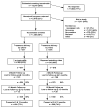Personality traits, perceived risk, and risk-reduction behaviors: a further study of smoking and radon
- PMID: 16846328
- PMCID: PMC2409280
- DOI: 10.1037/0278-6133.25.4.530
Personality traits, perceived risk, and risk-reduction behaviors: a further study of smoking and radon
Abstract
Personality traits and risk perceptions were examined as predictors of changes in smoking behavior. Participants (N = 697) were part of a randomized controlled trial of interventions to reduce exposure to the combined hazard of radon and cigarette smoke. Participants with higher perceived risk at baseline for the combination of smoking and radon were more likely to have a more restrictive household smoking ban in place at 12-month follow-up (p < .05). Risk perceptions also predicted reductions in the total number of cigarettes smoked in the home for participants in the video intervention who had high or moderate levels of extraversion (p < .01). Greater perceived risk predicted whether highly or moderately conscientious women quit smoking (p < .05). The moderating effects of personality traits should be considered when evaluating risk-reduction interventions.
Figures
References
-
- Aiken LS, West SG. Multiple regression: Testing and interpreting interactions. Newbury Park, CA: Sage; 1993.
-
- Bogg T, Roberts BW. Conscientiousness and health-related behaviors: A meta-analysis of the leading behavioral contributors to mortality. Psychological Bulletin. 2004;130:887–919. - PubMed
-
- Bohadana A, Nilsson F, Rasmussen T, Martinet Y. Gender differences in quit rates following smoking cessation with combination nicotine therapy: Influence of baseline smoking behavior. Nicotine and Tobacco Research. 2003;5:111–116. - PubMed
-
- Buss DM. Manipulation in close relationships: Five personality factors in interactional context. Journal of Personality. 1992;60:477–499. - PubMed
-
- Caldwell DF, Burger JM. Personality and social influence strategies in the workplace. Personality and Social Psychology Bulletin. 1997;23:1003–1012.


